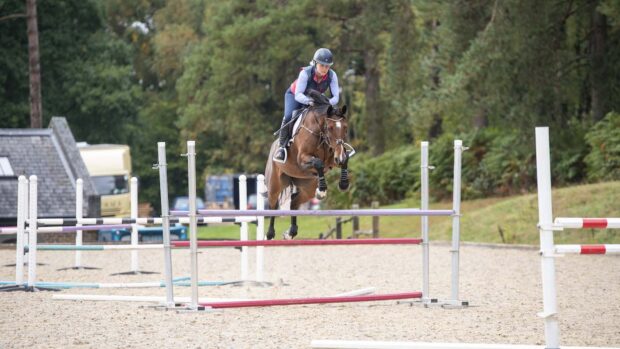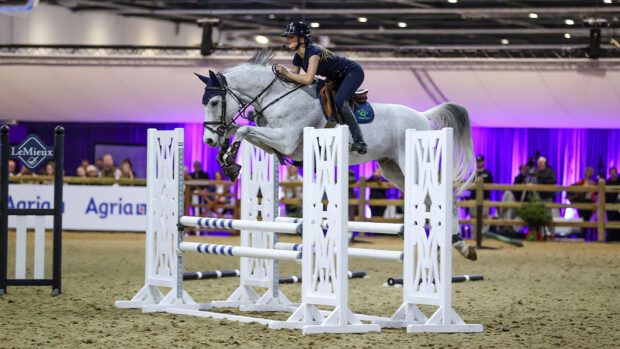There are some jumping questions that seem too obvious to ask your trainer — so we've asked them for you...
International showjumper Paul Crago gives the solutions to your questions — from tackling straightness to the value of polework and preventing rushing.
1. How can I avoid knockdowns?
Q: Although my horse jumps cleanly with his front feet, he often dangles a back leg and we usually pick up at least eight faults when we compete, which is frustrating. He’s keen and I’ve had his teeth, tack and back checked recently. Are there any exercises I can use to improve his technique? He’s a 10-year-old warmblood and we’re jumping 2ft 9in at unaffiliated shows.
A: You have done the right thing to have your horse’s teeth and back checked and as long as he is sound, you can help improve his technique behind. When you jump him, make sure that your position over the fence is correct. If you get left behind and are hanging onto his mouth over the fence, this won’t allow him to use his back end so he will have fences down behind. You can improve your position and your horse’s technique by working on gymnastic exercises and grids — I would suggest you find a trainer to help you with this. Practise keeping your hands soft over the fence and following his movement. You can also school over an ascending oxer with a back rail that’s higher than the front rail as this will encourage him to bascule and use his back end over the fence more.
2. Do you have any tips for straightness?
Q: My 10-year-old cob always jumps from left to right, however straight I try to keep him. Is there anything I can do to rectify this?
A: In a lot of cases when a horse jumps from left to right, or vice versa, there is an underlying physical problem. Your horse may be hurting somewhere and is jumping to the right away from the pain. The first step is to get him checked out by a good vet. His back, hocks and stifles should all be looked at. If he is sound, you need to check the way you are riding him. Some horses will jump to the left or right to give themselves more room if a rider is inclined to bring them too deep into a fence. Try to ride him in a nice rhythm and on a level stride. At home, you can try putting a pole on the right side of the fence, about 2-3ft inside the wing or using “V” poles, to help keep him straight. Keep your fences small and easy to give him confidence so he stays relaxed when you jump him. If your horse is frightened or tight when he jumps this may exaggerate the problem.
 Watch the video
Watch the video
3. What is a related distance?
Q: What are related distances and how do I work them out? I’ve just started jumping bigger classes and realise I can’t just “leave it to my horse” anymore, like I used to…
A: A related distance is a set number of horse strides between two fences on a course. To measure the distance yourself, stand with your back against the back pole of the first fence and walk two steps forward, to allow for where your horse will land. Then walk four more steps for each of your horse’s strides. After this, allow two more steps to the next fence, which is for your horse’s take-off. A three-stride distance, therefore, should be 2+4+4+4+2 or 16 steps. If you walked your three lots of four and there are less than two steps to the fence, then the distance will be short as there is less room for your horse to take off. If there are more than two steps then the distance will be a bit long. You can practise keeping your stride pattern even by walking distances at home, which you have measured yourself.
4. What is the secret to puissance success?
Q: What is the secret to success when jumping in puissance classes? My local venue has started introducing a “fun” high jump class and I’ve been thinking about entering my 12-year-old thoroughbred. The highest I’ve jumped her is 3ft 3in, but I think she’s got the scope to go further. Can I practise at home, should I just go for it on the day or will I risk overfacing her?
A: To be able to jump in, and win, a puissance class at top shows like Olympia, you need a specialist horse for the big wall. He has to have exceptional scope and be very brave. However, for the high jump class at your local venue a horse who has a reasonable jump and is honest should be OK for you to have some fun on. If the show centre is using a wall for the high jump it’s advisable for you to practise over this type of fence to give you both confidence. When a fence gets higher, you don’t have to go faster to jump it. If you do you will end up long and flat and will have it down. The secret to jumping a big fence is to keep the hocks engaged and the canter really balanced to give the horse power to get up in the air and over the fence. You are better off being a little bit closer to the fence rather than standing off — if you stand off you will invite that long, flat jump.
5. Is polework pointless?
Q: Is polework really necessary? My instructor told me I need to do more of it at home, but I’m not sure why, or how it’s going to help us.
A: There is a vast range of polework exercises and many reasons for using them. Trot and canter poles teach horse and rider the feeling and importance of balance and rhythm. Canter poles also help the rider to look for the fence and ride a correct line to it. The beauty of polework is that you can use it anywhere and in many different ways to practise your ringcraft, without the fear of getting into trouble and crashing through the fence if you make a mistake. This is especially important for inexperienced combinations. Poles are also a good way to break up the monotony of flatwork and keep the horse keen. I would suggest you go back to your instructor and ask them exactly what polework you should be doing and why.
Continued below…

Gemma Tattersall: how to make skinnies easy
Not a big fan of narrow fences? Gemma Tattersall explains an exercise to make skinnies easier to tackle
6. How can I cope with spooky fillers?
Q: What’s the best way to introduce a spooky horse to fillers? Showjumps seem to be getting more and more colourful, and my gelding is a bit of a nervous chap.
A: Spooky fillers are common in today’s courses and your horse needs to be introduced to them gradually and professionally. The first thing to remember is to give your horse confidence and get him to trust you so that when you ask him to jump a filler you are telling him that it is safe to do so. Your riding must be correct and positive. Introduce him to brightly coloured poles on the ground, working up to small fences. Once confident, introduce small fillers, putting them at the side of the fence with a gap between for the horse to jump through. Slowly push them together until they touch. Jump a wide variety of fillers at home and go to schooling venues to practise without the pressure of a show environment.
7. How can I stop my horse rushing?
Q: My horse gathers speed between fences when I’m jumping a course, and ignores my half-halts. He always clears the fence, but occasionally taps one. My instructor says that I lean too far forward into the fences from around two strides away, which is why my horse rushes. I can’t feel I’m doing it, or understand how it’s affecting his jump.
A: Jumping is all about good control, balance and rhythm. If you lean forward on the approach to a fence you are in front of the movement and out of balance, so your horse will rush to try to keep up with you. If you can’t feel that you are tipping forward, I suggest that you ask someone to take a video of you jumping. When you’re jumping in the ring, keep your horse moving forward in a balanced rhythm, especially around your turns and into your fences. If you can do this you will find that a stride will come a lot easier. The other important point to concentrate on is looking where you’re going and finding your line to a fence. A very common fault in riders is not eyeing up the fence early enough.



